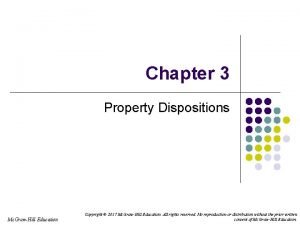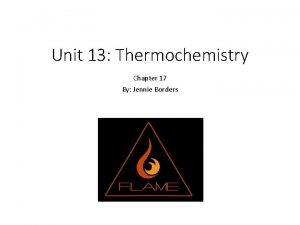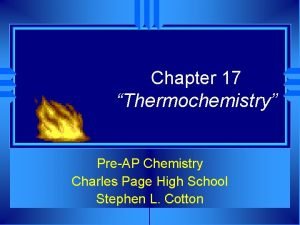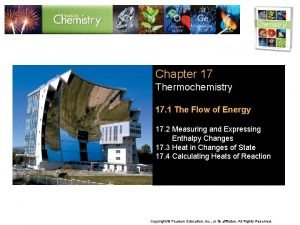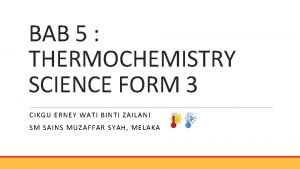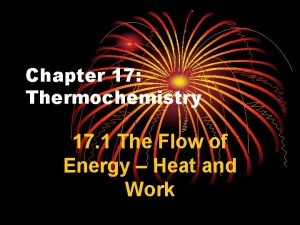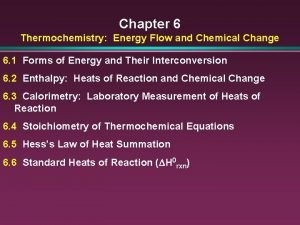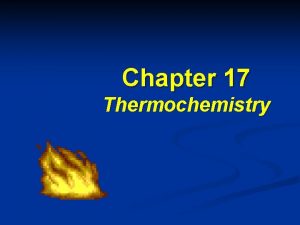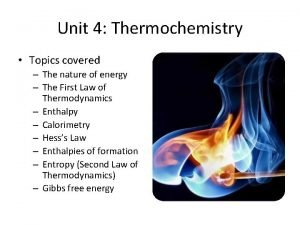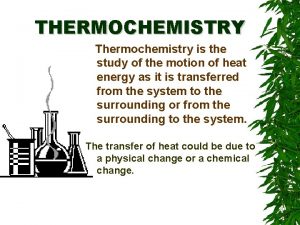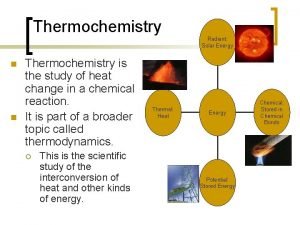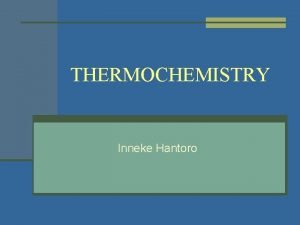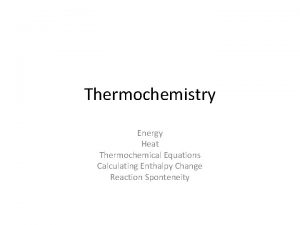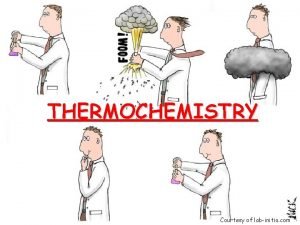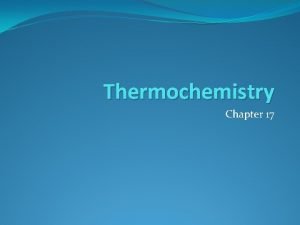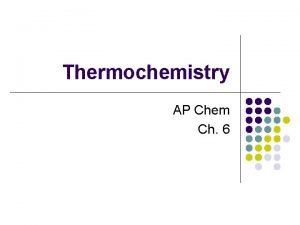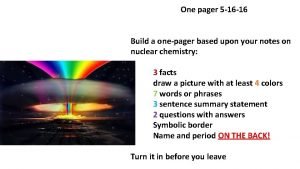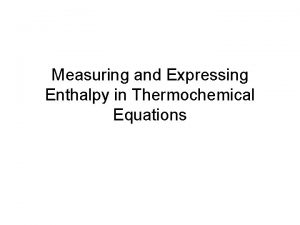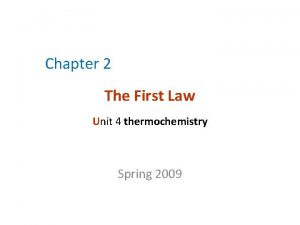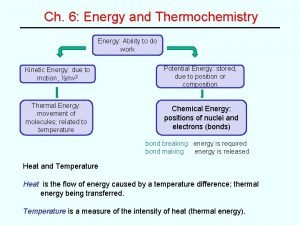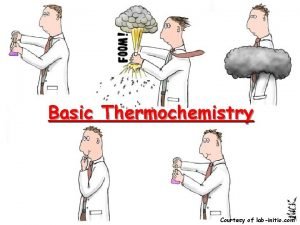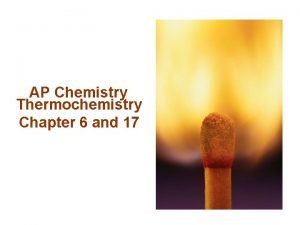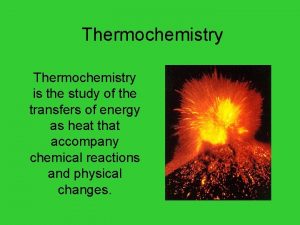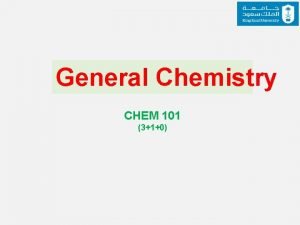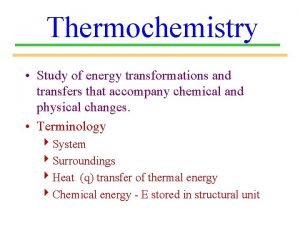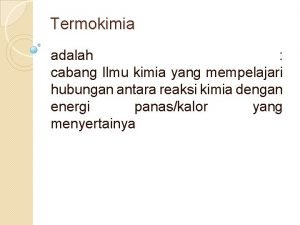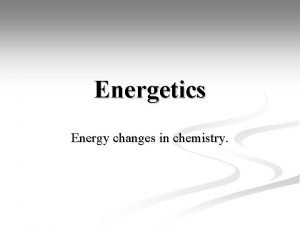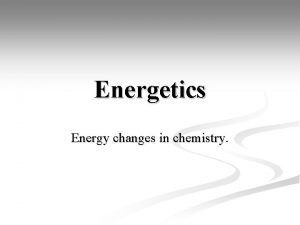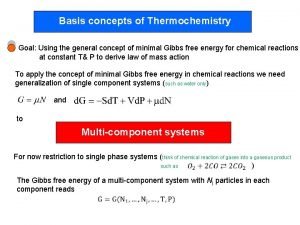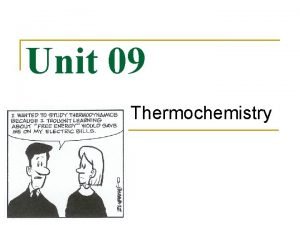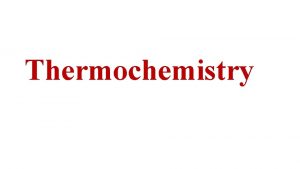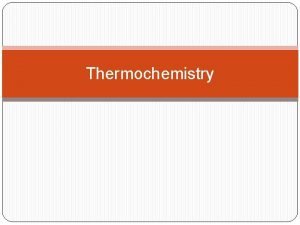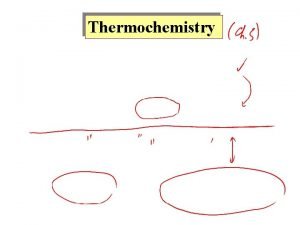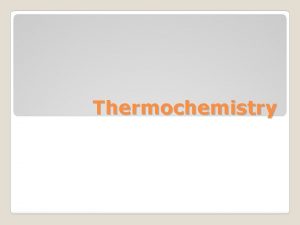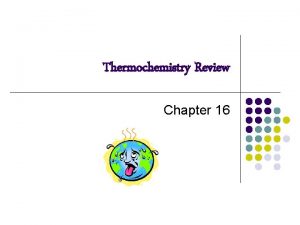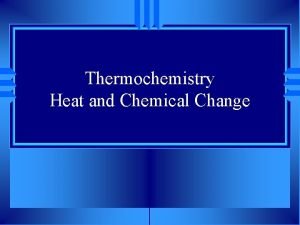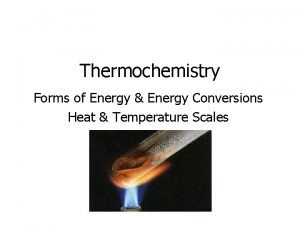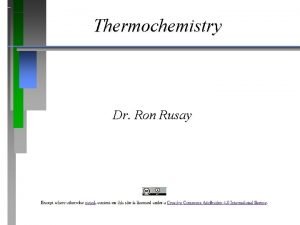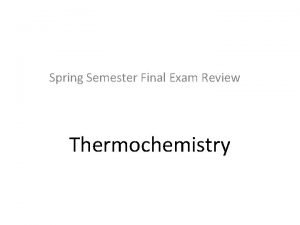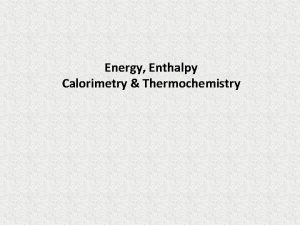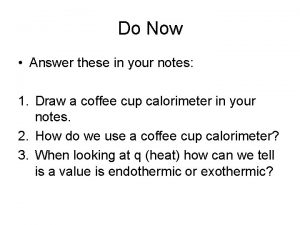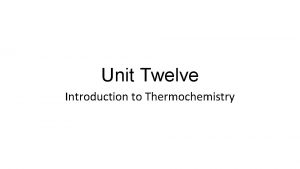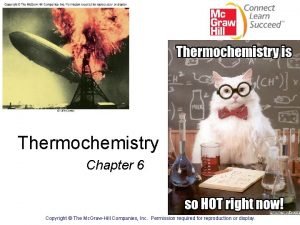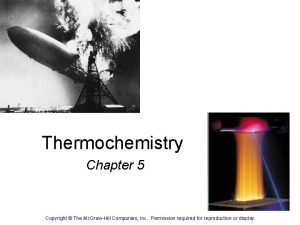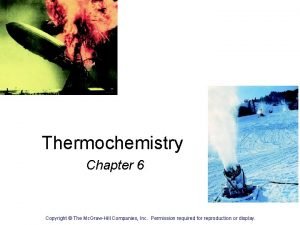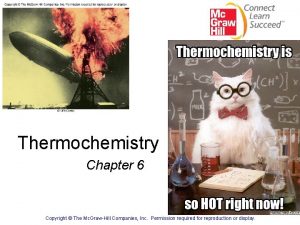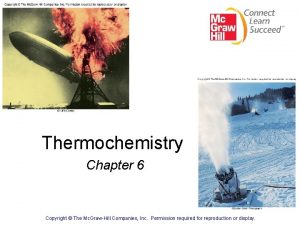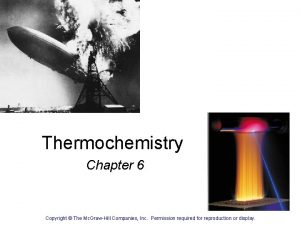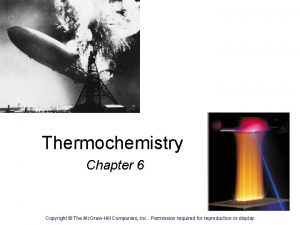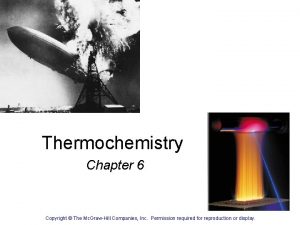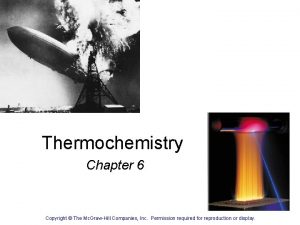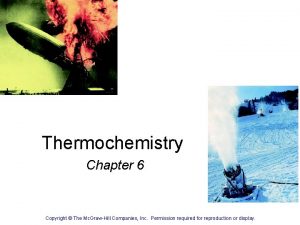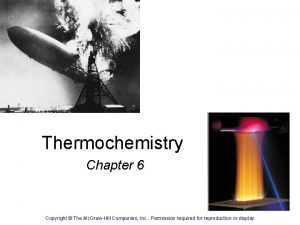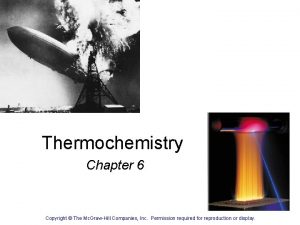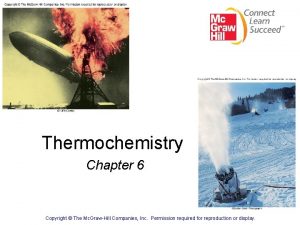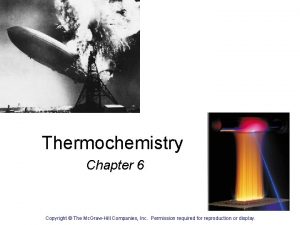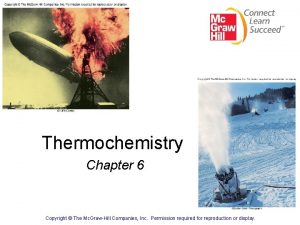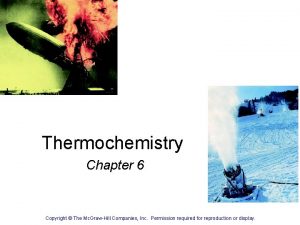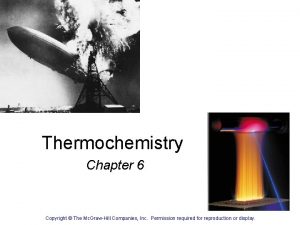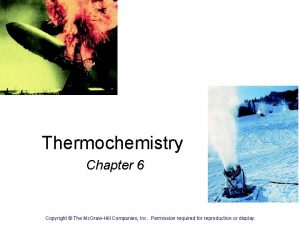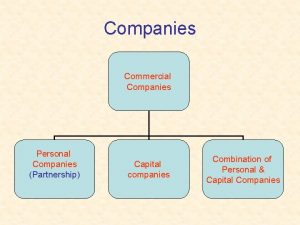Thermochemistry Chapter 6 Copyright The Mc GrawHill Companies























































- Slides: 55

Thermochemistry Chapter 6 Copyright © The Mc. Graw-Hill Companies, Inc. Permission required for reproduction or display.

The following items will be discussed : 6 -1 - The nature of energy and types of energy 6 -2 - Energy changes in chemical reactions 6 -3 - Introduction to thermodynamics 6 -4 - Enthalpy of chemical reactions 6 -5 -Calorimetry; the measurement of heat change. 6 -6 - Standard enthalpy of formation and reaction 6 -7 - Heat of solution and dilution

A LOOK AHEAD 1 -The study of the nature and the different types of energy. 2 - The study of heat change in chemical reactions, which is thermo chemistry. The vast majority of reactions are either endothermic (absorbing heat) or exothermic (releasing heat). 3 -The thermo chemistry is a part of a broad subject called the first law of thermodynamics, which is based on the law of conservation of energy. The change in internal energy can be expressed in terms of the changes in heat and work done of a system. 4 - The measure of the heat of reaction or calorimetry under constant-volume and constant-pressure, and the meaning of specific heat and heat capacity, quantities used in experimental work. Tro, Chemistry: A Molecular Approach 3

A LOOK AHEAD 5 - Knowing the standard enthalpies of formation of reactants and products enables us to calculate the enthalpy of a reaction. Discuss ways to determine these quantities either by the direct method from the elements or by the indirect method, which is based on Hess’s law of heat summation. 6 - Finally, the study the heat changes when a solute dissolves in a solvent (heat of solution) and when a solution is diluted (heat of dilution). Every chemical reaction obeys two fundamental laws; the law of conservation of mass and the law of conservation of energy. The mass relationships between reactants and products are discussed. Tro, Chemistry: A Molecular Approach 4

6 -1 - The nature of energy and types of energy Energy is : the capacity to do work Work “ directed energy change resulting from a process “ work = force x distance Types of energy : . Radiant energy • Thermal energy • Chemical energy • Nuclear energy • Potential energy • Kinetic energy

6 -1 - The nature of energy and types of energy Energy is defined as the capacity to do work. Work = force x distance Chemists define work as directed energy change resulting from a process. Kinetic energy: is the energy produce by a moving object : is one form of energy that is of particular interest to chemists. Other include radiant energy, thermal energy, chemical energy and potential energy. Tro, Chemistry: A Molecular Approach 6

6 -1 - Types of energy • Radiant energy comes from the sun and is earth’s primary energy source • Thermal energy is the energy associated with the random motion of atoms and molecules • Chemical energy is the energy stored within the bonds of chemical substances • Nuclear energy is the energy stored within the collection of neutrons and protons in the atom • Potential energy is the energy available by virtue of an object’s position • Kinetic energy consists of various types of molecular motion and the movement of electrons within molecules. 6. 1

6 -2 - Energy Changes in Chemical Reactions All Chemical reactions absorb or produce (release) energy in the form of heat. Heat is the transfer of thermal energy between two bodies that are at different temperatures. Temperature is a measure of thermal energy. Temperature = Thermal Energy 900 C 400 C greater thermal energy 6. 2

Some examples of energy conversion The work Form of the energy The converted energy form Thermal energy Stand in sunlight Radiant energy Do exercises Chemical energy stored in the bodies Kinetic energy A ball starts to roll downhill Potential energy Kinetic energy It is impossible to measure the total energy of a system certainly but the change in energy can be determined experimentally.

6 -3 - Introduction to thermodynamics Thermochemistry is part of a broader subject called thermodynamics The system is the specific part of the universe that is of interest in the study. open Exchange: mass & energy closed isolated energy nothing 6. 2

Thermodynamics is the scientific study of the inter -conversion of heat and other kinds of energy. State functions are properties that are determined by the state of the system, regardless of how that condition was achieved. energy, pressure, volume, temperature DE = Efinal - Einitial DP = Pfinal - Pinitial DV = Vfinal - Vinitial DT = Tfinal - Tinitial Potential energy of hiker 1 and hiker 2 is the same even though they took different paths. 6. 3

Exothermic process is any process that gives off heat – transfers thermal energy from the system to the surroundings. 2 H 2 (g) + O 2 (g) 2 H 2 O (l) + energy H 2 O (g) H 2 O (l) + energy Endothermic process is any process in which heat has to be supplied to the system from the surroundings. energy + 2 Hg. O (s) 2 Hg (l) + O 2 (g) energy + H 2 O (s) H 2 O (l) 6. 2

Exothermic Endothermic 6. 2

First law of thermodynamics : energy can be converted from one form to another, but cannot be created or destroyed. DEsystem + DEsurroundings = 0 or DEsystem = - DEsurroundings C 3 H 8 + 5 O 2 3 CO 2 + 4 H 2 O Exothermic chemical reaction! Chemical energy lost by combustion = Energy gained by the surroundings system surroundings The internal energy of a system has two components; kinetic energy and potential energy. The kinetic energy component consists of various types of molecular motion and the movement of electrons within molecules. Potential energy is determined by the attractive interactions between electrons and nuclei and by repulsive interactions between electrons and between nuclei in individual molecules, as well as by interaction between molecules. 6. 3

Example Consider the reaction between 1 mole of sulfur and 1 mole of oxygen gas to produce 1 mole of sulfur dioxide: S(s) + O 2(g) SO 2(g) This system composed of the reactant molecules S and O 2 and the product molecules SO 2. We don’t know the internal energy of the reactants and the products, but we can measure the change in energy content, ΔΕ = E (product) – E (reactant) = energy content of 1 mol SO 2(g) – energy content of [1 mol S(s) + 1 mol O 2(g)] Tro, Chemistry: A Molecular Approach 15

First Law of Thermodynamics *Conservation of Energy *For an exothermic reaction, “lost” heat from the system goes into the surroundings *two ways energy “lost” from a system, 1 - converted to heat, q 2 - used to do work, w *Energy conservation requires that the energy change in the system equal the heat released + work done DE = q + w DE = DH + PDV DE is a state function * internal energy change independent of how done Tro, Chemistry: A Molecular Approach 16

Another form of the first law for DEsystem DE = q + w DE is the change in internal energy of a system q is the heat exchange between the system and the surroundings w is the work done on (or by) the system w = -PDV when a gas expands against a constant external pressure Although neither heat q nor work w is a state function, their sum + w) is equal to DE where E is a state function. (q 6. 3

Work and Heat work can be defined as force F multiplied by distance d: w = Fd One way to illustrate mechanical work is to study the expansion or compression of a gas (see Fig. (6. 5)). The work done by the surroundings is: w = - PΔV where ΔV, the change in volume, is given by Vf - Vi Tro, Chemistry: A Molecular Approach 18

Work Done On the System w = F x d W = -P A d = - P DV DV > 0 F P x V = 2 x d 3 = F x d = w d -PDV < 0 wsys < 0 Work and heat are not a state functions! Dw = wfinal - winitial final Dq = qfinal - qinitial 6. 3

A sample of nitrogen gas expands in volume from 1. 6 L to 5. 4 L at constant temperature. What is the work done in joules if the gas expands (a) against a vacuum and (b) against a constant pressure of 3. 7 atm? w = -P DV (a) DV = 5. 4 L – 1. 6 L = 3. 8 L P = 0 atm W = -0 atm x 3. 8 L = 0 L • atm = 0 joules (b) DV = 5. 4 L – 1. 6 L = 3. 8 L P = 3. 7 atm w = -3. 7 atm x 3. 8 L = -14. 1 L • atm 101. 3 J = -1430 J w = -14. 1 L • atm x 1 L • atm 6. 3

Worked Example 6. 1


6 -4 - Enthalpy of chemical reactions Enthalpy and the First Law of Thermodynamics DE = q + w At constant pressure: qp = DH and w = -PDV DE = DH - PDV DH = DE + PDV At constant volume DV = 0 W = - PDV W = P X 0 = 0 DE = qv – 0 = qv qv = DH DE = DH 6. 4

* The two factors that determine thermodynamic favorability are the enthalpy and the entropy. * The enthalpy is a comparison of the bond energy of the reactants to the products. * bond energy = amount needed to break a bond. DH * The entropy factors relates to the randomness/orderliness of a system DS * The enthalpy factor is generally more important than the entropy factor Tro, Chemistry: A Molecular Approach 24

Enthalpy of Reactions Because most of reactions are constant pressure processes, we can equate the heat change to the change in enthalpy. For any reaction such as: A (reactant) B (product) the change in enthalpy, called the enthalpy of reaction, ΔH = H (products) – H (reactants) Tro, Chemistry: A Molecular Approach 25

Entropy entropy is a thermodynamic function that increases as the number of energetically equivalent ways of arranging the components increases, S ·S generally J/mol S = k ln W k = Boltzmann Constant = 1. 38 x 10 -23 J/K W is the number of energetically equivalent ways, unitless Tro, Chemistry: A Molecular Approach 26

Enthalpy (H) is used to quantify the heat flow into or out of a system in a process that occurs at constant pressure. DH = H (products) – H (reactants) DH = heat given off or absorbed during a reaction at constant pressure Hproducts < Hreactants DH < 0 Hproducts > Hreactants DH > 0 6. 4

Thermochemical Equations Is DH negative or positive? System absorbs heat Endothermic DH > 0 6. 01 k. J are absorbed for every 1 mole of ice that melts at 00 C and 1 atm. H 2 O (s) H 2 O (l) DH = 6. 01 k. J 6. 4

Thermochemical Equations Is DH negative or positive? System gives off heat Exothermic DH < 0 890. 4 k. J are released for every 1 mole of methane that is combusted at 250 C and 1 atm. CH 4 (g) + 2 O 2 (g) CO 2 (g) + 2 H 2 O (l) DH = -890. 4 k. J 6. 4

Thermochemical Equations • The stoichiometric coefficients always refer to the number of moles of a substance H 2 O (s) H 2 O (l) • If you reverse a reaction, the sign of DH changes H 2 O (l) H 2 O (s) • DH = 6. 01 k. J DH = -6. 01 k. J If you multiply both sides of the equation by a factor n, then DH must change by the same factor n. 2 H 2 O (s) 2 H 2 O (l) DH = 2 x 6. 01 = 12. 0 k. J 6. 4

Thermochemical Equations • The physical states of all reactants and products must be specified in thermochemical equations. H 2 O (s) H 2 O (l) DH = 6. 01 k. J H 2 O (l) H 2 O (g) DH = 44. 0 k. J How much heat is evolved when 266 g of white phosphorus (P 4) burn in air? P 4 (s) + 5 O 2 (g) P 4 O 10 (s) DH = -3013 k. J 266 g P 4 x 1 mol P 4 123. 9 g P 4 x 3013 k. J = 6470 k. J 1 mol P 4 6. 4

Worked Example 6. 3

A Comparison of DH and DE 2 Na (s) + 2 H 2 O (l) 2 Na. OH (aq) + H 2 (g) DH = -367. 5 k. J/mol DE = DH - PDV At 25 0 C, 1 mole H 2 = 24. 5 L at 1 atm PDV = 1 atm x 24. 5 L = 24. 5 L. atm = 2. 5 k. J DE = -367. 5 k. J/mol – 2. 5 k. J/mol = -370. 0 k. J/mol In case of ideal gases and at constant temperature DE = DH – RT Dn 6. 4

Worked Example 6. 4

6 -5 - Calorimetry The specific heat (s) Heat capacity (C) Heat (q) absorbed or released q = m x s x Dt q = C x Dt

6 -5 - Calorimetry : the measurement of heat change. The specific heat (s) of a substance is the amount of heat (q) required to raise the temperature of one gram of the substance by one degree Celsius. The heat capacity (C) of a substance is the amount of heat (q) required to raise the temperature of a given quantity (m) of the substance by one degree Celsius. C = m x s Heat (q) absorbed or released: q = m x s x Dt q = C x Dt Dt = tfinal - tinitial 6. 5

How much heat is given off when an 869 g iron bar cools from 940 C to 50 C? s of Fe = 0. 444 J/g • 0 C Dt = tfinal – tinitial = 50 C – 940 C = -890 C q = ms. Dt = 869 g x 0. 444 J/g • 0 C x – 890 C = -34, 000 J 6. 5

Worked Example 6. 5

Worked Example 6. 6

6. 5

Chemistry in Action: Fuel Values of Foods and Other Substances C 6 H 12 O 6 (s) + 6 O 2 (g) 6 CO 2 (g) + 6 H 2 O (l) DH = -2801 k. J/mol 1 cal = 4. 184 J 1 Cal = 1000 cal = 4184 J Substance DHcombustion (k. J/g) Apple -2 Beef -8 Beer -1. 5 Gasoline -34

6 -6 - Standard enthalpy of formation and reaction Because there is no way to measure the absolute value of the enthalpy of a substance, must I measure the enthalpy change for every reaction of interest? Establish an arbitrary scale with the standard enthalpy of formation (DH 0) as a reference point for all enthalpy expressions. Standard enthalpy of formation (DH 0 f ) is the heat change that results when one mole of a compound is formed from its elements at a pressure of 1 atm. The standard enthalpy of formation of any element in its most stable form is zero. DH 0 f (O 2) = 0 DH 0 f (C, graphite) = 0 DH 0 f (O 3) = 142 k. J/mol DH 0 f (C, diamond) = 1. 90 k. J/mol 6. 6

6. 6

0 ) is the enthalpy of The standard enthalpy of reaction (DHrxn a reaction carried out at 1 atm which can be determined by: The direct method a. A + b. B c. C + d. D DH 0 rxn = [ c. DH 0 f (C) + d. DH 0 f (D) ] - [ a. DH 0 f (A) + b. DH 0 f (B) ] DH 0 rxn = S n. DH 0 f (products) - S m. DHf 0 (reactants) The indirect method Hess’s Law: When reactants are converted to products, the change in enthalpy is the same whether the reaction takes place in one step or in a series of steps. (Enthalpy is a state function. It doesn’t matter how you get there, only where you start and end. ) 6. 6

C (graphite) + 1/2 O 2 (g) CO (g) + 1/2 O 2 (g) CO 2 (g) C (graphite) + O 2 (g) CO 2 (g) 6. 6

Calculate the standard enthalpy of formation of CS 2 (l) given that: 0 = -393. 5 k. J C(graphite) + O 2 (g) CO 2 (g) DHrxn 0 = -296. 1 k. J S(rhombic) + O 2 (g) SO 2 (g) DHrxn 0 = -1072 k. J CS 2(l) + 3 O 2 (g) CO 2 (g) + 2 SO 2 (g) DHrxn 1. Write the enthalpy of formation reaction for CS 2 C(graphite) + 2 S(rhombic) CS 2 (l) 2. Add the given rxns so that the result is the desired rxn. 0 = -393. 5 k. J C(graphite) + O 2 (g) CO 2 (g) DHrxn 0 = -296. 1 x 2 k. J 2 S(rhombic) + 2 O 2 (g) 2 SO 2 (g) DHrxn 0 = +1072 k. J + CO 2(g) + 2 SO 2 (g) CS 2 (l) + 3 O 2 (g) DHrxn C(graphite) + 2 S(rhombic) CS 2 (l) 0 = -393. 5 + (2 x-296. 1) + 1072 = 86. 3 k. J DH rxn 6. 6

Benzene (C 6 H 6) burns in air to produce carbon dioxide and liquid water. How much heat is released per mole of benzene combusted? The standard enthalpy of formation of benzene is 49. 04 k. J/mol. 2 C 6 H 6 (l) + 15 O 2 (g) 12 CO 2 (g) + 6 H 2 O (l) DH 0 rxn = S n. DH 0 f (products) - S m. DHf 0 (reactants) DH 0 rxn = [ 12 DH 0 f (CO 2) + 6 DH 0 f (H 2 O)] - [ 2 DH 0 f (C 6 H 6)] DH 0 rxn = [ 12 x– 393. 5 + 6 x– 187. 6 ] – [ 2 x 49. 04 ] = -5946 k. J = - 2973 k. J/mol C 6 H 6 2 mol 6. 6

Worked Example 6. 9

Worked Example 6. 10

6 -7 - Heat of solution and dilution The enthalpy of solution (DHsoln) is the heat generated or absorbed when a certain amount of solute dissolves in a certain amount of solvent. DHsoln = Hsoln – Hcomponents Which substance (s) could be used for melting ice? Which substance (s) could be used for a cold pack? 6. 7

The Solution Process for Na. Cl DHsoln = Step 1 + Step 2 = 788 – 784 = 4 k. J/mol 6. 7

DHsoln = U – Hhydration Na. Cl (s) Na+ (g) + Cl- (g) U = 788 k. J / mol Na+ (aq) + Cl- (aq) DH = - 784 k. J/mol ___________________________ Na. Cl (s) Na+ (aq) + Cl- (aq) DH = 4 k. J/mol

The heat of dilution is the heat change associated with the dilution process , if a certain solution process is endothermic and the solution is diluted, more heat will be absorbed by the same solution from the surrounding. In case of dilution H 2 SO 4 this process is so exothermic that you must never attempt to dilute the concentrated acid by adding water to it. The recommended procedure is to add the concentrated acid slowly to the water while constantly stirring.

Chemistry in Action: Bombardier Beetle Defense C 6 H 4(OH)2 (aq) + H 2 O 2 (aq) C 6 H 4 O 2 (aq) + 2 H 2 O (l) DH 0 = ? C 6 H 4(OH)2 (aq) C 6 H 4 O 2 (aq) + H 2 (g) DH 0 = 177 k. J/mol H 2 O 2 (aq) H 2 O (l) + ½O 2 (g) DH 0 = -94. 6 k. J/mol H 2 (g) + ½ O 2 (g) H 2 O (l) DH 0 = -286 k. J/mol DH 0 = 177 - 94. 6 – 286 = -204 k. J/mol Exothermic!

 Grawhill
Grawhill Grawhill
Grawhill 作業管理精簡版13版解答
作業管理精簡版13版解答 Grawhill
Grawhill Mc grawhill
Mc grawhill Single user multitasking os
Single user multitasking os Grawhill
Grawhill Mc grawhill
Mc grawhill Grawhill
Grawhill Chapter 17 thermochemistry practice problems answers
Chapter 17 thermochemistry practice problems answers Chapter 17 thermochemistry
Chapter 17 thermochemistry Chapter 17 thermochemistry answer key
Chapter 17 thermochemistry answer key Science form 3 chapter 5
Science form 3 chapter 5 Chapter 17 thermochemistry
Chapter 17 thermochemistry Chapter 6 thermochemistry
Chapter 6 thermochemistry Chapter 17 thermochemistry
Chapter 17 thermochemistry Three companies in business chapter 2
Three companies in business chapter 2 Gibbs free energy unit
Gibbs free energy unit Thermochemistry is the study of
Thermochemistry is the study of Thermochemistry is concerned with the study of
Thermochemistry is concerned with the study of Thermochemical equation
Thermochemical equation Thermochemistry
Thermochemistry Thermochemistry gaussian
Thermochemistry gaussian Thermochemical equation
Thermochemical equation Cartoon thermochemistry
Cartoon thermochemistry Chemistry semester 2 review unit 12 thermochemistry
Chemistry semester 2 review unit 12 thermochemistry Thermochemistry is study of
Thermochemistry is study of Thermochemistry equations
Thermochemistry equations Thermochemistry one pager
Thermochemistry one pager Thermochemical equation examples
Thermochemical equation examples Kirchhoff's law enthalpy example
Kirchhoff's law enthalpy example Thermochemistry equations
Thermochemistry equations Thermochemistry cartoon
Thermochemistry cartoon Thermodynamics ap chemistry
Thermodynamics ap chemistry Ap chemistry thermochemistry frq
Ap chemistry thermochemistry frq Thermochemistry is the study of
Thermochemistry is the study of General chemistry thermochemistry
General chemistry thermochemistry Study of energy transformations
Study of energy transformations Cabang ilmu kimia yang mempelajari perubahan kalor
Cabang ilmu kimia yang mempelajari perubahan kalor Energy changes
Energy changes What is thermochemistry
What is thermochemistry Thermochemistry concepts
Thermochemistry concepts Ap chemistry unit 9
Ap chemistry unit 9 Thermochemistry is study of
Thermochemistry is study of Energy diagram thermochemistry
Energy diagram thermochemistry Thermochemistry is concerned with the
Thermochemistry is concerned with the Kinetic energy thermochemistry
Kinetic energy thermochemistry Thermochemistry
Thermochemistry A piece of metal is heated then submerged in cool water
A piece of metal is heated then submerged in cool water Intro to thermochemistry
Intro to thermochemistry Thermochemistry video
Thermochemistry video Thermochemistry conversions
Thermochemistry conversions Thermochemistry
Thermochemistry Thermochemistry exam review
Thermochemistry exam review State and explain hess's law of constant heat summation.
State and explain hess's law of constant heat summation. Calorimeter
Calorimeter






